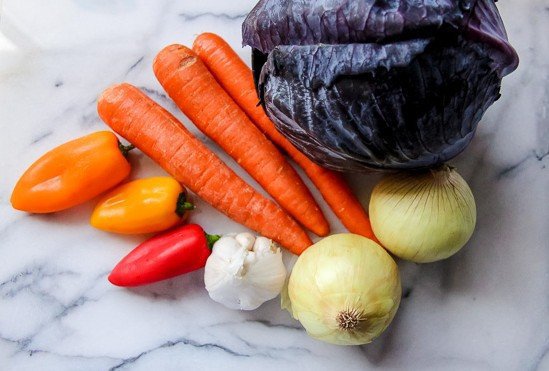Fermenting is a simple way to implement remarkable nutrition into one’s diet. Fermented foods, such as sauerkraut and kimchi, have been made and consumed around the world for ages. If you have never tried fermented foods before, then the strong taste may seem a little strange at first. Yet you may find that after giving it a try, your body may even begin to crave a helping each day.
Recently, the importance of probiotics in our diets is becoming more increasingly evident. The benefits of eating yogurts and kefir, drinking kombucha and beet kvass, and eating many more fermented/lacto fermented foods, have great value when regularly consumed. There is a long list of veggies that taste wonderful when fermented, and all have the same probiotic benefits of introducing healthy bacteria (flora) into your body to regulate your digestive system, improve bowel health, improve immunity, and in some cases, to even slow or reverse illnesses. It has even been suggested that fermented foods help to rid the body of toxins such as heavy metals!
Fermenting is very cost effective because you can do it with ingredients found around the kitchen, and the choice of veggies is really up to you: what you have on hand and according to your family’s taste.
Product Recommendation
If you are looking for all of the benefits of fermenting but do not wish to ferment foods yourself, we recommend Reed’s Culture Club Kombucha.
Simple Veggie Blend
Ingredients:
- 2-3 wide mouth quart mason jars
- 2 1/2 tsp. (2 tsp. per jar) (We recommend this organic Pink Himalayan salt)
- Water
- 1 head of purple Cabbage ( this gives your fermented veggies a beautiful color and it tastes amazingly fermented!)
- 1 yellow onion
- 3-4 Carrots
- 1/2 bell pepper or 2-4 baby bell peppers
- 1 clove of garlic (optional) With fermenting, a little garlic goes a long way.
HOW TO:
- Cut the cabbage into very thin strips.
- Slice onion at about the same thickness.
- Julienne the carrots and mince garlic. (We love this Julienne Peeler & Veggie Peeler Combo tool)
- Toss all veggies in a bowl with 1 tsp. of salt and mix.
- With a meat mallet or other clean and heavy object, pound the veggies for a good 10 minutes until juices begin to form beneath. This will allow vegetables to better absorb brine. ( This is also a great time to the kids involved.)
- Fill a mason jar 1/3 full at a time sprinkling in about 1/2 tsp salt and packing down veggies tightly with mallet or other utensil.
- Fill jar until about 1 inch of space remains at the top
- Set lid on jar and tighten very loosely. (Do not tighten lid! Lid will begin to tighten some on its own as fermentation begins.)
- Put jars in a cool place and loosen lid once each day and press vegetables back under brine with a fork if needed.
- By the second or third day you should be seeing a fizzy or bubbling effect, if any foam is present skim and discard..
- After the first two or three days begin to taste veggies until desired flavor has been reached.
Leave veggies to ferment for anywhere from 1 week to 1 month depending upon desired taste. When desired taste is reached simply tighten lids and put mason jars into refrigerator.


Fermented Radishes
Ingredients:
-
-
- 1 quart mason jar
- 1 package or roughly 30-40 fresh organic radishes
- 3 Tblsp. Salt
- 4 cups of water
- 1 clove of Garlic (optional)
-
HOW TO:
- Cut stems and tails off of radishes.
- Cut radishes into bite-size pieces (halves or fourths).
- Mince garlic.
- Fill jar with radishes leaving about 1/2 of space at the top of jar and set aside.
- In a sauce pan, bring water to a boil and add salt, stir until dissolved.
- remove from heat and allow to cool.
- after salt water is cool pour over radishes
- Place lid on and tighten slightly (do not tighten completely)
Allow radishes to ferment on a countertop or in a cool place for 4-5 days until radishes have turned almost completely white. Tighten lid and place into refrigerator.
Here are some other great ingredients to try: beets, kohlrabi, cucumbers, green cabbage, parsnips, sweet potatoes, bell peppers, lemon and herbs such as basil, sage, rosemary, and thyme.

Photo credits: Kirsten H.
This post is meant for educational purposes only. It is not intended to replace medical advice from your physician, doctor or health care professional. Please read our terms of use for more information.










































